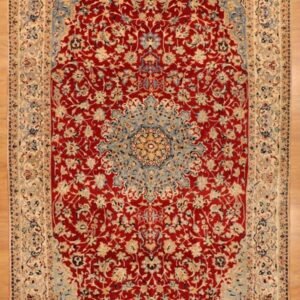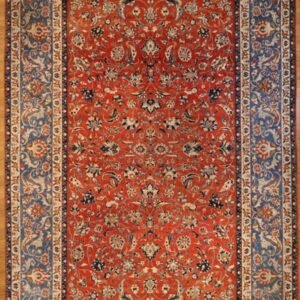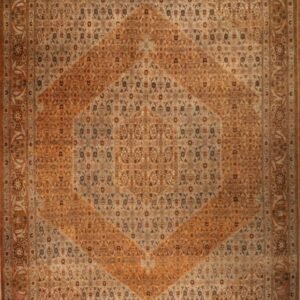Serial No.: 0009809
Origin: Caucasian, Azerbaijan
Town: Unknown
Age: Circa 1920
Style: Tribal Geometric, Sumak Technique
Size: 8′ x 12′
Material: Wool pile and wool foundation, vegetable dyed
Color Scheme: Ivory, Red, Turquoise, Salmon, Navy, Green, Orange
Condition: Minor Repairs
Expert Description
This expansive rug, dating to circa 1920, is a distinguished example of Caucasian tribal textile artistry from Azerbaijan, executed in the Sumak technique. Although its precise town of origin remains unidentified, the piece reflects the robust and innovative weaving traditions characteristic of the region.
Weaving Technique & Materials
The rug is constructed on a wool foundation with a wool pile, both sourced from local flocks renowned for their resilient fibers. It is produced using the Sumak technique, a method where colored wefts are wrapped around the warps rather than being fully knotted, resulting in a flat or semi-pile surface that showcases sharp, well-defined geometric motifs. The use of vegetable dyes—with madder for rich reds, indigo for deep blues, and other natural botanicals for turquoise, salmon, green, and ivory tones—imbues the rug with a vibrant yet harmonious color palette. The natural dyeing process, known for creating subtle tonal variations (abrash), adds depth and an organic quality to the design.
Design & Motifs
The design is predominantly tribal geometric, featuring a network of interlocking medallions and angular patterns that convey both rhythm and symmetry across the 8′ x 12′ field. Notably, the composition includes a dragon design motif, an element of profound cultural and symbolic importance. In Caucasian and Azerbaijani textile traditions, the dragon is more than a decorative figure—it represents power, protection, and auspicious energy. Often interpreted as a guardian of the home or a symbol of fertility and prosperity, the dragon motif in this rug is rendered with bold lines and intricate detail, ensuring it stands out amidst the geometric array. Its inclusion not only enhances the aesthetic complexity of the piece but also serves as a talisman, echoing the mythological narratives and collective beliefs of the weavers.
Cultural & Historical Context
During the early decades of the 20th century, weaving in the Caucasus was a deeply communal activity, often carried out in family-run workshops that passed down techniques and symbolic motifs over generations. The Sumak technique, in particular, was valued for its ability to produce textiles that were both functional and richly expressive. The dragon motif, as employed in this rug, reflects a synthesis of ancient tribal symbolism and the dynamic visual language of the region’s weavers. It served as a protective emblem, imbuing the textile with layers of cultural meaning that resonated with both local traditions and broader mythological themes prevalent in Azerbaijani folklore.
Artistic Significance
In excellent condition, this rug stands as a testament to the technical proficiency and creative vision of its makers. Its bold color scheme and meticulously executed Sumak technique not only highlight the high level of craftsmanship but also connect modern audiences with the historic textile practices of the Caucasus. The interplay of vibrant hues—ranging from the warm intensity of red and salmon to the cool elegance of turquoise, navy, and green—creates a dynamic visual narrative that is both striking and enduring.
Collectively, the piece is an invaluable artifact that encapsulates the intersection of art, culture, and technique in Caucasian rug-making. The presence of the dragon motif enhances its stature as a culturally significant object, imbuing it with symbolism that continues to captivate collectors and scholars alike. This rug is not only a decorative masterpiece but also a storied link to the rich, evolving heritage of Azerbaijani textiles, where each element—woven with care and imbued with meaning—speaks to a legacy of tradition and artistic innovation.







Reviews
There are no reviews yet.